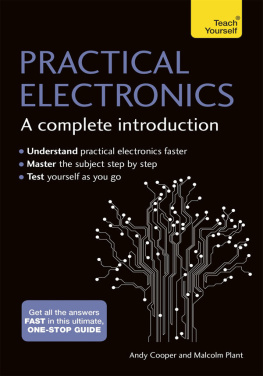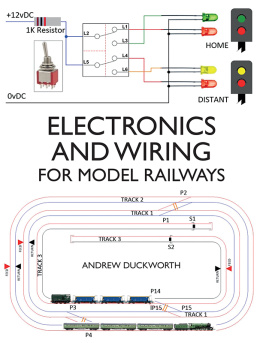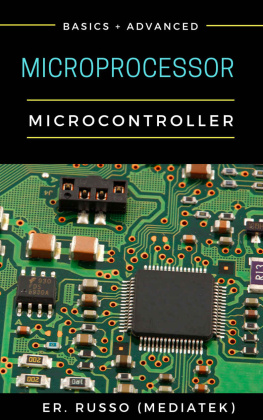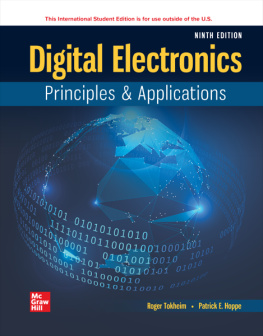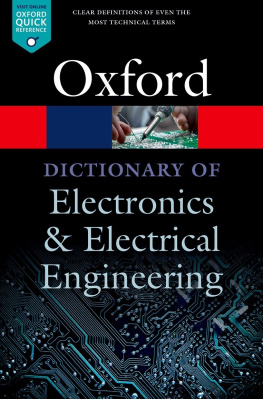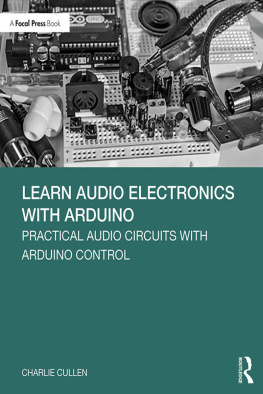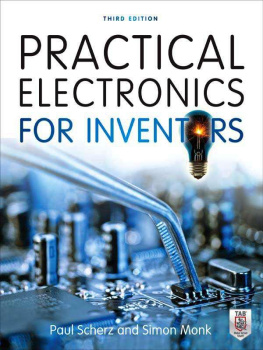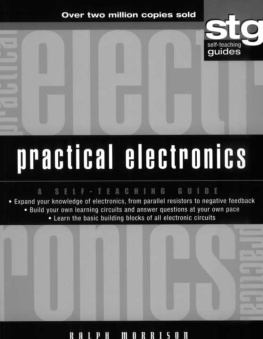PRACTICAL ELECTRONICS
A Complete Introduction
Andy Cooper
Andy Cooper has been fascinated by electronics since his grandfather told him stories about the early days of radio of neighbours listening around a pudding bowl containing a carbon earpiece to broadcasts from a crystal set. He worked in various industries on projects including monitoring radioactive isotopes, avionics displays, torpedo sensing systems and measuring forces involved in tooth brushing before finally settling to a career in education.
Andy worked with the BBC and LEGO on some of the first computer control projects. He later coordinated the ICON team at Nottingham Trent University, which developed one of the first microcontroller systems for education. He has spent time working with British School Technology on national teacher-training programmes and with Design and Technology primary and secondary teacher training at Nottingham Trent University. The annual Robot Race and Dance Challenge became a favourite feature in his calendar.
Andy received the IET Award for Digital Design and Technology in 2010. Since retiring, Andy has developed an on-line Make It Move course for the National STEM Centre and served as a trustee for the Design and Technology Association. He is currently coordinating the D&T component of the teacher-training programme for the BBC micro:bit Roadshow.
To Anne, Emma and James.
Acknowledgements
Writing Teach Yourself Practical Electronics has been more of a challenge than I expected and a humbling experience when I quickly realized what I had forgotten and what I didnt understand in the first place. Having spent most of my career in education and sadly watched over the diminishing role of electronics education in schools I have been prompted to consider what inspired me to take on one of the most conceptually demanding subjects.
Early influences are important and I still carry memories of my grandfather talking about his early days running a radio repair business in the 1920s. Neighbours would gather on a Saturday evening to listen to radio broadcasts on a crystal receiver with an earpiece in a pudding bowl. I remember the front room filled with cardboard boxes of components and wires and the corrugated tin shed with massive glass bottles packed in straw and filled with sulphuric acid for batteries. My interest was encouraged by my secondary-school science teacher, Sydney Sharp, who gave me an electronic kit to dabble with during lunch breaks and guided me away from seeking employment in the local cardboard-box factory to take on a scientific assistant role at AERE Harwell. The next step was the City University to study Physics. Industrial placements working with avionics displays, measuring forces involved in tooth brushing and designing torpedo guidance systems made me realize that I lacked the creative flair for electronic design. My interests lay in helping others learn about electronics and my career path in teaching was established.
I am mindful of the quote by Sir Isaac Newton, in a letter to Robert Hooke: If I have seen further it is by standing on the shoulders of giants. We all owe a debt to the early pioneers of electricity and electronics but I would like to particularly thank people who have had a direct influence on me and the ideas that underpin this book:
Keith Roberts, LEA Advisor, Cheshire and George Studd, Headteacher, Weaverham High School, who encouraged my role with the development of the Cheshire Electronics Systems kits and teaching course
Dr John Martin of Salford University for his inspirational ideas including systems electronics and the Microelectronics for All kit
Geoff Shillito OBE and Professor Geoffrey Harrison at the Nottingham Trent University for the opportunities to develop national electronics programmes with British School Technology working on projects with the BBC, LEGO and Kuwait
Bill Ghee and Al Kicks for ten years of creative adrenalin rush with the ICON Project, which pioneered the introduction of microcontrollers in education in the UK. Thanks also to Mike Ive, HMI, Andy Breckon, CEO, D&T Association and Professor Nigel Hastings, Nottingham Trent University for their encouragement, and to Mel Hughes, Commotion, for marketing and distribution and Geoff Hallam, Nottingham Trent University for technical support
Sarah Davies, Senior Lecturer, Nottingham Trent University for the ideas for textile electronics. Fran Dunkley and Andrew Lambley, Senior Technicians, Nottingham Trent University for the additional support with the Robot Racer Challenge competitions
Members of the national Electronics in Schools development team: Jim Neale, LEA Advisor Hertfordshire and Trainer for New Wave Concepts; Dr Peter Branson, LEA Advisor, Staffordshire; Paul Gardiner, developer of Daisy PIC electronics for textiles; Nick Baldwin, Technology Enhancement Programme; Steve Wells, Institution for Engineering and Technology
Colleagues who contributed to the Make It Move STEM courses: Andy Mitchell, D&T Association; Hugh Johnson, the Education Consultant who worked with me on the design of the STEM models; Geoff Hampson, Director Kitronik for handling design, manufacture and distribution; Joseph Birks, Redfern Electronics Limited, for guidance with the innovative IQ
The students and teachers who have inspired me with some amazing achievements.
Finally, thanks to those who have made a direct input of ideas for this book:
Colleagues: Les Porter, Ideas into Action; Rowan Todd, Subject Group Leader for the Centre for Design & Technology Education, Sheffield Hallam University; Dr David Barlex, Education Consultant; Torben Steeg, Education Consultant; Claire Molinario, Institution for Engineering and Technology; Richard Green, CEO D&T Association; Emma Watson, D&T Association
Companies that have given support for the design and practical testing of circuits used in the book: New Wave Concepts for the use of Circuit Wizard and Genie, which have been used to prepare and test many of the circuits; Kitronik for the loan of practical kits and use of photographs
Mentoring and support: Malcolm Plant, the author of the earlier Teach Yourself book on electronics who has given generous use of his time to mentor this project; Brenda Smith for the all-important cakes; and encouragement and Dave Quick for the music. Finally, Iain Campbell, Publishing Director, John Murray Learning, and the team, and Robert Tuesley Anderson who has worked magic with the editing.
Photographic credits
The author and publisher would like to thank Kritonic Ltd (www.kitronik.co.uk) and New Wave Concepts (www.new-wave-concepts.com) for permission to reproduce photographs of practical kit and equipment used throughout this book.
Additional credits: ).
Every effort has been made to trace the ownership of copyright material. Information that will enable the publisher to rectify any error or omission in subsequent reprints will be welcome. In such cases, please contact John Murray Learning, Carmelite House, 50 Victoria Embankment, London EC4Y 0DZ.
Contents
Introduction
How to use this book
This book has been written for students, teachers and enthusiasts taking their first steps into electronics. It blends information on the social impact of electronics with the rationale, history, theory, designing and practice, with a particular emphasis on the latest microcontroller technologies, which allow beginners to create their own electronic designs. Microcontroller programs are presented using an introductory generic flowchart format, which can be readily adapted for application in specific microcontroller software editors.

